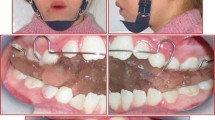Abstract
Background and Aim:
Cover-bite (“Deckbiss”) is regarded as a highly relapse-prone malocclusion. In this context the great significance of a high lip line (LipL) as an etiologic factor for the retroclination of the upper central incisors was recently proven within the framework of lip pressure measurements. It therefore seemed likely that a persisting high LipL after correction of cover-bite might have an equally negative impact on the stability of the treatment outcome.
Materials and Methods:
This issue was investigated in the present retrospective study by cephalometric analysis of the findings prior to therapy (T1), immediately after active mechanotherapy (T2), and after a mean follow-up period of 2 years (T3). The study group consisted of 40 former cover-bite patients with initial linguoversion of the upper central incisors (axial angle to anterior cranial base < 98°) and anterior deep bite (≥ 4 mm) from the records of the Department of Orthodontics, University of Freiburg i. Br., Germany.
Results and Conclusions:
The average relapse was ca. 20% of the total correction of the anterior linguoversion and deep bite, with the relapse tendency, however, displaying substantial interindividual variations. Multiple regression analysis revealed an increased relapse tendency in specific cases: patients with maxillary extractions, cases with a pronounced therapeutically induced change of upper central incisor inclination, and patients with a high post-therapeutic LipL or with poor compliance in the retention phase. In view of the relatively good opportunity to influence the level of the LipL therapeutically, one of the most important therapeutic objectives for cover-bite patients should be to reduce the amount by which the lower lip overlaps the upper incisors (to a maximum value of 3 mm). This can be achieved by active mechanical intrusion of the upper incisors. If the orthodontist fails to take account of this aspect when planning or performing the treatment, he has to accept an increased risk of relapse.
Zusammenfassung
Hintergrund und Ziel:
Der Deckbiss wird als sehr rezidivfreudige Anomalie angesehen. Im Zusammenhang damit konnte kürzlich im Rahmen von Lippendruckmessungen die große Bedeutung einer hohen Lippenschlusslinie (LipL) als ätiologischer Faktor für die Retroinklination der mittleren oberen Inzisivi nachgewiesen werden. Es lag daher die Vermutung nahe, dass sich eine posttherapeutisch hohe LipL ebenso negativ auf die Behandlungsstabilität nach kieferorthopädischer Korrektur des Deckbisses auswirken könnte.
Material und Methoden:
Dieser Fragestellung wurde in der vorliegenden retrospektiven Studie mittels kephalometrischer Auswertung der Befunde vor der Therapie (T1), direkt nach der aktivmechanischen Therapie (T2), sowie nach einer mittleren posttherapeutischen Beobachtungszeit von 2 Jahren (T3) nachgegangen. Als Untersuchungsgruppe dienten 40 ehemalige Deckbisspatienten mit initialem Steilstand der mittleren oberen Inzisivi (Achsenwinkel zur vorderen Schädelbasis < 98°) sowie frontalem Tiefbiss (≥ 4 mm) aus dem Archiv der Kieferorthopädischen Abteilung des Universitätsklinikums Freiburg i. Br.
Ergebnisse und Schlussfolgerungen:
Durchschnittlich rezidivierten jeweils etwa 20% des Gesamtausmaßes der Korrektur des frontalen Steilstandes und Tiefbisses, wobei jedoch die Rezidivtendenz individuell sehr unterschiedlich ausfiel. Mittels multipler Regressionsanalyse konnte nachgewiesen werden, dass die Neigung zum Rezidiv in bestimmten Fällen erhöht war: Hierzu zählten Patienten mit Extraktionen im Oberkiefer (OK), Fälle mit starker therapeutischer Inklinationsveränderung der mittleren oberen Inzisivi sowie Patienten mit hoher posttherapeutischer LipL oder mit schlechter Mitarbeit in der Retentionsphase. Im Hinblick auf die relativ gut mögliche therapeutische Einflussnahme auf die Höhe der LipL sollte es bei Deckbisspatienten als eines der wichtigsten therapeutischen Ziele angesehen werden, die Überlappung der oberen Inzisivi durch die Unterlippe (auf einen maximalen Wert von 3 mm) zu reduzieren. Dies kann durch aktiv-mechanische Intrusion der oberen Inzisivi erreicht werden. Falls der Behandler diesen Aspekt bei der Planung bzw. Durchführung der Therapie außer Acht lässt, muss er sich eines erhöhten Rezidivrisikos bewusst sein.
Similar content being viewed by others
Author information
Authors and Affiliations
Corresponding author
Rights and permissions
About this article
Cite this article
Lapatki, B.G., Klatt, A., Schulte-Mönting, J. et al. A Retrospective Cephalometric Study for the Quantitative Assessment of Relapse Factors in Cover-Bite Treatment. J Orofac Orthop 65, 475–488 (2004). https://doi.org/10.1007/s00056-004-0412-1
Received:
Accepted:
Issue Date:
DOI: https://doi.org/10.1007/s00056-004-0412-1




